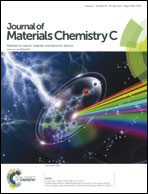A novel luminescent monolayer thin film based on postsynthetic method and functional linker†
Abstract
Herein, we report on a new strategy for fabricating a luminescent monolayer thin film by modified metal–organic frameworks (MOFs). Lanthanide ion (Eu3+, Tb3+ and Yb3+) is first introduced to MOFs (MOF-253), and then the second ligand, i.e. TTA or TAA (TTA = 2-thenoyltrifluoroacetone and TAA = 1,1,1-trifluoropentane-2,4-dione), is used to further sensitize the lanthanide ion. Finally, the MOFs modified by the lanthanide complex are assembled on a quartz plate by a functional linker. The as-prepared MOF thin film is a dense and transparent monolayer, and its thickness is less than 100 nm. Four kinds of optically functionalized MOF thin film are prepared by this method.


 Please wait while we load your content...
Please wait while we load your content...